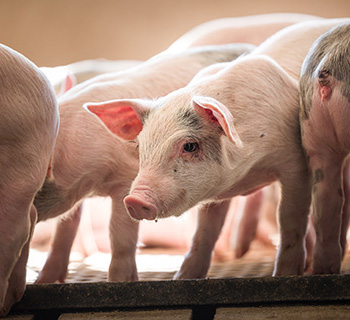Manage E. coli in the nursery
 The bacterial disease caused by pathogenic Escherichia coli (E. coli) has made a resurgence in US nurseries. Scours, death loss, and poor gain are symptoms of E. coli that producers with affected herds have had to deal with.
The bacterial disease caused by pathogenic Escherichia coli (E. coli) has made a resurgence in US nurseries. Scours, death loss, and poor gain are symptoms of E. coli that producers with affected herds have had to deal with.
Dr. Dean Boyd, a nutritionist who retired from Hanor and Triumph Foods; Dr. Ken Mooney, swine nutritionist with Cargill; and Dr. Kathryn Price, swine nutritionist with Cargill; took part in a podcast to review the causes and potential solutions to help minimize the effects of E. coli infection in nursery barns.
“In the recent past, we’ve had pathogenic E. coli breaks at a point in the nursery we haven’t experienced before,” says Boyd. “What’s striking is that farms that previously didn’t have breaks are now having problems. There are even some new farms that are putting out healthy pigs that will break with E. coli F18 mid-nursery.”
Zinc oxide
“We’re using zinc oxide at a 1200 to 1250 ppm range all the way through the nursery,” says Mooney. “The biggest problem is getting the fermentable protein to the high gut. To reduce that, we reduce crude protein and the ingredients that might be causing the problem. We reduce soybean meal levels and increase further-processed soybean products.”
Producers need to be careful with zinc oxide levels – over-feeding zinc in the nursery can lead to lameness issues in the finisher phase. That’s why phase-feeding is important.
There is also new interest in the reduction of calcium in the diet because it buffers the gut, he says.
“For my customer with the largest problem, we reduced the levels of calcium and increased the organic acids in the diet,” he says. “We also acidified the water to increase the acidification in the gut to help keep those pathogens down.”
Don’t forget fiber
Price notes the importance of fiber in controlling E. coli, saying “Different fiber types can help stimulate the gut and help it mature. If you look at a more fermentable fiber source, it can help with the ideal microbiota profile and allow us to limit the bad bacteria and help the good bacteria flourish.
“We also know that the more phytate we have released, the better the reduction in scours, not to mention the improvements in performance we can get by simply super-dosing phytase in our diets,” she adds.
Phase-feeding can help
Phase-feeding can help a disease-susceptible animal transition more smoothly through the nursery.
“With E. coli breaking later in the nursery, I’ve started a split diet from about 22 pounds to 35 pounds, and then from 35 lbs. to when they’re done in the nursery, and that seems to help,” Mooney says.
With E. coli issues in the first diet, he lowers the lysine to get the gut set up and get the pig eating. Using citric acid in the water has also shown value, however, it’s important to make sure water lines are clean.
Cargill has focused on the fibers, because they’re not all the same, says Price. Structural and fermentable fibers are evaluated.
“We use a structured type of carbohydrate (like rice hulls or wheat bran) early on in the diet for gut stimulation. Then as we transition to an older animal we use the fermentable fibers – perhaps a beet pulp or soy hulls. Beet pulp is an old technology that’s been around – but it contributes to the fermentable fiber function.”
This can continue out to the end of the nursery period and maybe even into the finisher.
What about rolled oats?
Everyone loves rolled oats, says Price. “They have a good profile and can be soothing to the gut to help us meet various specifications in the diet. We tend to use higher levels of oats in the Nurture™ program for that reason.”
On the other hand, oats are expensive, points out Mooney. “We’ll use it later in the diet if the problems are severe enough, but take it out as quickly as we can. Like zinc, the use of oats early and often in diets can be detrimental. Performance can be hurt by what producers do to solve E. coli issues,” he says.
Begin a program
“If a customer says he’s starting to break with E. coli, there are three things we can do right away,” says Mooney. “We lower the calcium to bring up acidification; split into two diets, and lower the lysine levels. That’s the temporary hold until we figure out a long-term plan.”
“Our job as nutritionists is to be nimble and quick,” says Price. “We have to be ready with a plan when the call comes. We also need to recognize nutrition can only take us so far. We need to work with the veterinarian and the producer to see what else might be occurring…we need help from the whole system to tackle an issue.”
To watch the full podcast with these three experts, click here.
